Written by: Shahida JJ - Posted on: September 27, 2013 |  Comments
Comments
Google Translation: اُردو | 中文
Taking PIA from Islamabad's Benazir Bhutto International Airport, via Lahore to Delhi's Indra Gandhi International (IGI) airport, - airports in the capital cities of neighboring countries, Pakistan and India, named after their women Prime Ministers, and both tragically assassinated. Landed on May 1, 2013, at the IGI New Delhi airport, to attend the ADB's 46th Annual Meeting, hosted by India.
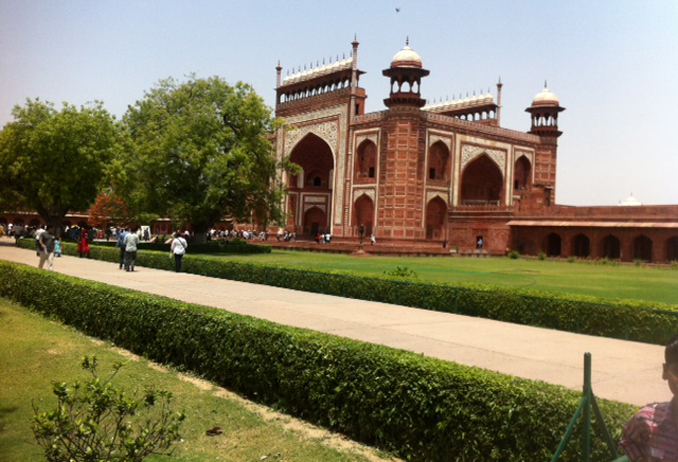 |
| Entrance to the Taj |
Indira Gandhi International (IGI) Airport has been ranked the second best airport in the world, according to the 2011 Airport Service Quality rankings of Airport Council International (ACI). It is in Palam, 16 km from Delhi city center, spread over miles, and next to the airport is a new complex of hundreds of new hotels, all kinds and all names - top class- still under construction.
Greater Noida, the venue of the ADB AM, is in Utter Pradesh, the new Tech City that has only high rises for miles and miles, at a one and half hour drive from Delhi city: it will one day look like New York City!
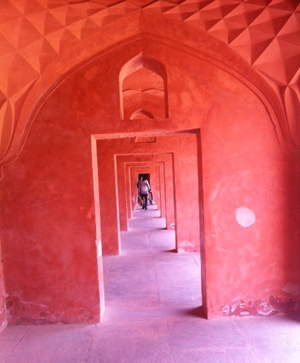 |
| Arched walkways |
We - the ADB alumni, stayed at a newly constructed 5 star German chain Kempinski Hotel, just outside Delhi city - a little hard to pronounce name!
We had four days of full day activities: Seminars, conferences, knowledge sharing sessions, city tours, lunches, receptions and dinners. The President of the ADB, Mr. Takehiko Nakao hosted a reception for the 4000 delegates from 67 countries, that served superb Japanese food.
The Host Country Banquet entertained us with a lavish spread of exotic Indian vegetarian food, and a beautiful cultural programme: The SARI - A Contemporary Dance Performance.
May 5 was a free day that we fully took advantage of.
Three women staying at the Kempinski Hotel decided to take a day trip to Agra to visit the Taj Mahal, and went Dutch - sharing all costs. The car arranged by the hotel cost us Rs. 7000 - $ 140/- for the day trip to Agra and back.
We emptied our hotel room mini bar of all of its contents: water, soft drinks, juices, nuts, cookies and snacks, and the hotel restaurant packed for us fresh fruit for the day.
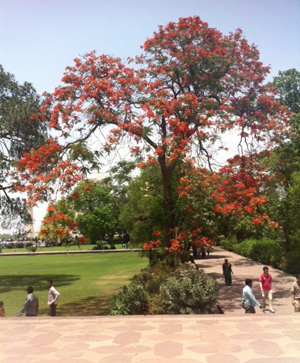 |
| Full tree in bloom at the Taj |
We were:
Cinnamon Dornsife (Ambassador), an American, who is the Associate Director of the International Development Program at John Hopkins University, US. She was a Director on the Board of Directors of the ADB and worked for the Asia Foundation in Indonesia, while Ann Soetoro (President Obama's mother) worked for the Ford Foundation; they worked together on joint programs and were collegial friends.
Elizabeth V Reyes, Liz, a Filipina, an artist and an author, who has published 10 coffee table books, on the interior design and architecture of Filipino residences, that showcases the myriad tastes of the Philippines.
And me, A Pakistani, Founder Vice Chancellor of Sardar Bahadur Khan Women's University, Quetta, Pakistan. Have spent 23 years in the development sector, working with and for the underprivileged rural poor of Pakistan.
Cinnamon had been to the Taj previously and this was her third visit. She said: Her first visit was when she was young. She took the local train and a taxi as young tourists did. Her second visit was as ADB Board member, with official protocol, hooting escort vehicles. And the third was the three women together, on a hotel rented car!
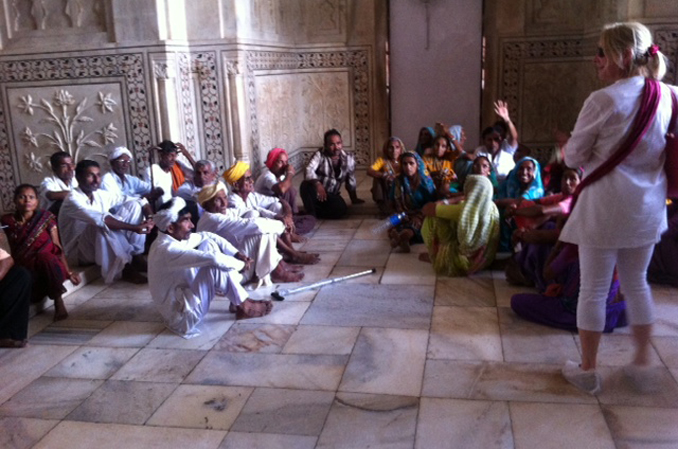 |
| Locals visiting the Taj |
For Liz and me, it was our first time.
A car came at 7 am, but had balding tires, was quickly sent back by the Concierge. Replacement was no better, seemed old and not road worthy for the long drive to Agra and worth our money, but we took it any way. The driver was a small man, not English conversant, and had somewhat shaky driving. He let go of the steering wheel when he received a call on his cell. We were told by the driver that he received instructions on his cell that a replacement car was being sent as his was not good and meant for another party for within the city trip- we waited on the side of the Expressway.
A better air-conditioned car came as replacement, with an English speaking uniform clad driver and we were on our way.
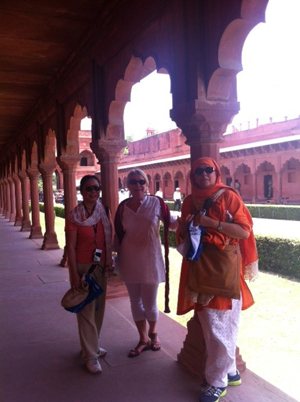 |
| Us three in the corridors of the Taj Compound |
It was a Sunday, and the wide new 4 lane dual carriage way - Expressway had no traffic. It was very hot, at 41°C temperature under the shade.
The route was flat land with harvested wheat fields, just like our Motorway. And in addition to cows, there were deer/ gazelle and Nilgai and according to our guide cum driver, they are pests, damaging and eating crops, as no one hunts or kills them. I thought of my father, a great hunter, who would regularly visit Rahimyar Kahn for hiran shikar (deer hunt) and also shot Nilgai along the Indian border in the Bahawalpur region.
The two and a half hour drive went by vary fast, as the three of us talked and discussed, shared our lives, families, experiences, work, religion, social, political issues, and our passions. All have worked for development, worked for humanity, worked for making the world a better place to live in. And we snacked all along on the goodies we carried with us - and got to know each other very well.
Entry into Agra was not crowded; it was a typical Indian/Pakistani town; we passed by the red stone Fort, that is bigger than the Red Fort of Delhi. Forts were the Living quarters of the Emperors.
The Taj Mahal is located on the Jumna river- which is like the Lahore Ravi River, that had no water, and was like a gutter, with buffalos soaking in the dirty water and grazing on the dry patches of the river bed - nothing spectacular there!
Entrance fee for the Taj varied: Locals paid Rs. 20, $0.4/-
Foreigners, Rs. 750 - US $ 15. They earn an income from foreigners!! We were given disposable shoe covers to wear on our shoes, once inside the marble floored Taj.
We hired a guide for a small fee, and entered through the Great Gate. The view of the Taj from the entrance arch was breathtaking; we took lots of photos, posing for single photos and the three of us with the Taj in the background.
We walked to the white marble Taj. It was beautiful; very well kept and well maintained; it was sparkling clean. The water ponds were clean, the lawns and gardens well manicured, and no rubbish anywhere. Highly commendable – the agencies that maintain it and the public that does not destroy it.
It seemed everyone took pride in the monument and their heritage. Since it was Sunday, there were huge local crowds of visitors.
We drove back returning to the hotel at 4.30 pm, a bit tired and depleted of energy and exhausted due the very hot weather.
It was the experience of a lifetime: we had visited the Taj Mahal, constructed by an Emperor in loving memory of his wife- what a great tribute to a woman!
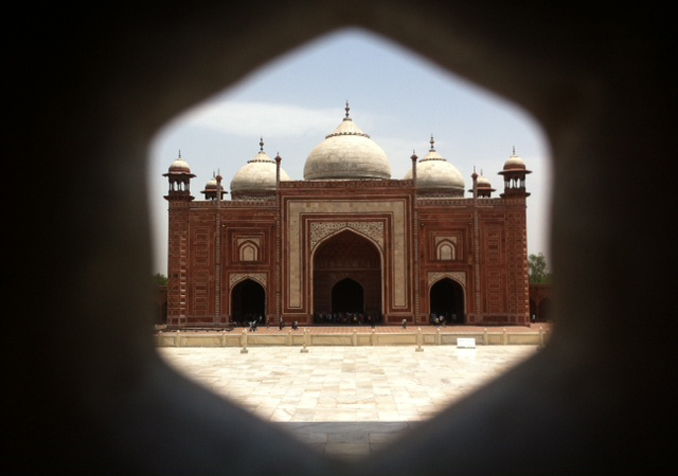 |
| View from a marble lattice |
Research on the Taj
In 1631, Shah Jahan, emperor during the Mughal empire's period of greatest prosperity, was grief-stricken when his third wife, Mumtaz Mahal, died during the birth of their 14th child, Gauhara Begum.
Construction of the Taj Mahal began in 1632.
Ustad Ahmad Lahauri, the Chief Architect of the Taj Mahal and who was a Persian-speaking Afghan from modern-day Badakhshan Province of Afghanistan, built it between 1632 and 1648.
The principal mausoleum was completed in 1648 and the surrounding buildings and garden were finished five years later.
The Great Gate (Darwaza-i Rauza)—is the gateway to the Taj Mahal
The tomb is the central focus of the entire complex of the Taj Mahal. This large, white marble structure stands on a square plinth and consists of a symmetrical building with an iwan (an arch-shaped doorway) topped by a large dome and finial. Like most Mughal tombs, the basic elements are Persian in origin.
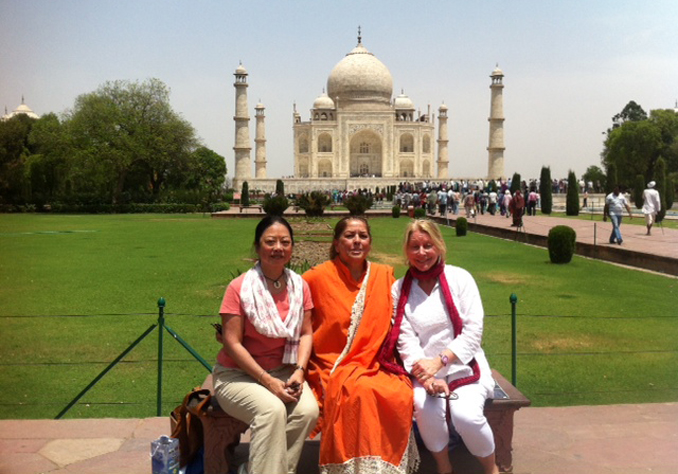 |
| The three of us In front of the Taj |
The complex is set around a large 300-metre (980 ft) square charbagh or Mughal garden.
The Taj Mahal complex is bound on three sides by crenellated red sandstone walls, with the river-facing side left open. Outside the walls are several additional mausoleums, including those of Shah Jahan's other wives, and a larger tomb for Mumtaz's favourite servant.
The Taj Mahal was constructed using materials from all over India and Asia and over 1,000 elephants were used to transport building materials. The translucent white marble was brought from Makrana, Rajasthan, the jasper from Punjab, and the jade and crystal from China. The turquoise was from Tibet and the the Lapis Lazuli from Afghanistan, while the sapphire came from Sri Lanka and the carnelian from Arabia. In all, twenty eight types of precious and semi-precious stones were inlaid into the white marble.
All of us left for our homes the next day, and exchanged photos and emails.
And we have been friends since the visit to the Taj, the three of us!